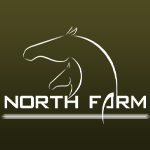Head on collisions, sideswipes, lane hogs and road rage…sounds like traveling down America’s busiest freeways, right?
Well, sure, or it could just be that you’re in the trail warm-up pen at any given horse show.
Probably since the beginning of horse shows, the warm-up pen has been a place where people forget that the world does not revolve around them. Wrecks happen, unkind words are exchanged, and it can be a rough place to be at a horse show, especially the trail pen.
GoHorseShow was interested to find out from both exhibitors and trainers, once and for all, what proper trail warm-up pen etiquette is, and how to make it a more enjoyable experience for all involved.
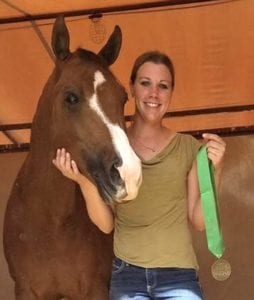 Torey Roderick – I try to tell my students a few critical points, and the more crowded and chaotic the trail pen is, the more important these become…
Torey Roderick – I try to tell my students a few critical points, and the more crowded and chaotic the trail pen is, the more important these become…
1) Navigating the trail pen should be like driving. Keep it smooth and try to avoid sudden stops and erratic turns. Go with the flow of traffic and don’t be that person who slams on your brakes on the freeway. If you missed your exit or don’t know where you’re going, gently pull over.
2) Treat the obstacles like rotaries or as if you’re a plane in a holding pattern waiting to land. Stay in the appropriate gear and direction for that obstacle and circle until you can get in. Only go as far away as you have to. Stay ready and watch for your turn.
3) Stopping. Sometimes you need to stop. If you do, look behind you or better yet, always have an idea of what’s going on around and behind you. Only stop if it’s clear. Try not to stop in “the road” or a visible path of travel and if you do, step out of the way as soon as possible.
4) Know your pattern. Read the map before you pull out of the driveway, not at a dead stop in the middle of a 4-way intersection. Help yourself and your trainer by having efficient schooling sessions.
5) Homework is done at home. If six people are waiting behind you to work the gate, take the time you need but don’t get carried away.
6) Sometimes less is more. If you are showing trail, chances are you and your horse are already reasonably well versed in all the elements that can make up a course. Practice is about feeling out which path is best and putting all the parts together. Don’t make yourself crazy. Chances are, after a drag and reset, the course will ride differently at showtime anyway. In some cases, if practice conditions seem more detrimental than beneficial, I won’t even do a warm-up. Trust your skills and your horse and take full advantage of walking the course.
 Tim (The Trail Man) Kimura – 1) To start with, for those who own the trail equipment. I hate to see them raise the poles using the cones on their side and bending them.
Tim (The Trail Man) Kimura – 1) To start with, for those who own the trail equipment. I hate to see them raise the poles using the cones on their side and bending them.
2) Putting poles on top of flower boxes or other poles and walls raising them so high the horses smash the flowers, break the boxes and walls, damage the poles a lot…or even snap some poles.
3) Raising the poles so high that green and novice horses can’t practice too.
4) Walking the course while horses are trying to practice and work the obstacles.
5) Trainers standing in the line of travel while schooling their students preventing others from using the course too.
5) Sitting in an impediment talking or on the phone while others are waiting to use it.
6) Going through the obstacle when staff is trying to rake the spots to improve the footing between the poles.
7) Going over the same obstacle more than three times in a row and not sharing. Even though you’re having issues, you are making everyone wait.
8) Cutting in front of the group that’s waiting their turn to work an obstacle.
9) Practicing without permission to start when we first build the course, and it’s not finished yet. We hate that.
10) Being rude or on the phone or texting, while having no clue where everyone else is located.
 Emma Brown – I think the biggest thing is when the warm-up arena is so small, everyone is trying to warm up, and it gets cluttered. When the warm-up pen is small, and people stand around for long periods before or after they begin the warm-up process, it can get to be a bit discouraging to those who are trying to warm up at that time. Mainly, keep your eyes up and watch for others and be considerate, everyone deserves a good chance to warm up.
Emma Brown – I think the biggest thing is when the warm-up arena is so small, everyone is trying to warm up, and it gets cluttered. When the warm-up pen is small, and people stand around for long periods before or after they begin the warm-up process, it can get to be a bit discouraging to those who are trying to warm up at that time. Mainly, keep your eyes up and watch for others and be considerate, everyone deserves a good chance to warm up.
 Carey Nowacek – The trail warm-up pen can be a scary place to be at times. I think we all have to remember that no one is trying to sabotage another person or purposely get in someone’s way. The best thing to do is keep a heads up approach and try not to spend too long on one obstacle if others are waiting. A considerate thing to do if you are having trouble in an obstacle and needing to do one piece a few times, if people are waiting, move on to something else and come back to that obstacle later.
Carey Nowacek – The trail warm-up pen can be a scary place to be at times. I think we all have to remember that no one is trying to sabotage another person or purposely get in someone’s way. The best thing to do is keep a heads up approach and try not to spend too long on one obstacle if others are waiting. A considerate thing to do if you are having trouble in an obstacle and needing to do one piece a few times, if people are waiting, move on to something else and come back to that obstacle later.
 Melissa Zanetti – In general, I think folks are pretty cooperative with one another in the trail warm-up area. However, I may have a few thoughts on the issue. One of my pet peeves is people walking the warm-up pattern on foot while others are riding. It concerns me because I think it can be dangerous. Another is when people are riding the obstacles, guiding their horse with one hand and holding the pattern in their other. Inevitably, they are more focused on learning the pattern than being courteous to the other riders. Lastly, I think it is a little inconsiderate to be riding on the warm-up pattern when there are others who are showing that day that need the obstacles to do their last minute preparations. Again, I enjoy my fellow competitors immensely; these are areas I would change if I could.
Melissa Zanetti – In general, I think folks are pretty cooperative with one another in the trail warm-up area. However, I may have a few thoughts on the issue. One of my pet peeves is people walking the warm-up pattern on foot while others are riding. It concerns me because I think it can be dangerous. Another is when people are riding the obstacles, guiding their horse with one hand and holding the pattern in their other. Inevitably, they are more focused on learning the pattern than being courteous to the other riders. Lastly, I think it is a little inconsiderate to be riding on the warm-up pattern when there are others who are showing that day that need the obstacles to do their last minute preparations. Again, I enjoy my fellow competitors immensely; these are areas I would change if I could.
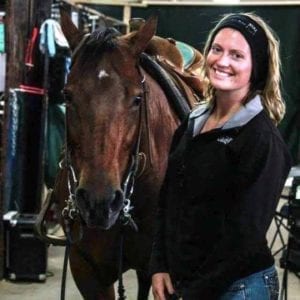 Caitlin Schneider – Be kind! We’re all warming up and know space is limited, so why not be nice and try to make the best of it. Try to have some idea of the pattern before coming to practice and ask questions if you’re unsure of how an obstacle should be ridden before you go through. Also, try not to cut people off who are already clearly headed to an obstacle. During trail practice, the gate and backup are usually always occupied, so maybe go to another obstacle first that is less busy and come back to it.
Caitlin Schneider – Be kind! We’re all warming up and know space is limited, so why not be nice and try to make the best of it. Try to have some idea of the pattern before coming to practice and ask questions if you’re unsure of how an obstacle should be ridden before you go through. Also, try not to cut people off who are already clearly headed to an obstacle. During trail practice, the gate and backup are usually always occupied, so maybe go to another obstacle first that is less busy and come back to it.
 Hayley Riddle – There is so much that happens in a crowded trail warm up and most of it we can’t control. One thing that drives me crazy is an obstacle hog. Someone who is doing an obstacle fine and having no issues on it but keeps going over it and won’t let anyone have a turn. Some of the main things that make a trail pen hectic are people who don’t pay attention to others around them and also people who can’t steer. When you ride in a crowded trail pen, make sure you pay attention, can drive through the crowd and don’t hog an obstacle.
Hayley Riddle – There is so much that happens in a crowded trail warm up and most of it we can’t control. One thing that drives me crazy is an obstacle hog. Someone who is doing an obstacle fine and having no issues on it but keeps going over it and won’t let anyone have a turn. Some of the main things that make a trail pen hectic are people who don’t pay attention to others around them and also people who can’t steer. When you ride in a crowded trail pen, make sure you pay attention, can drive through the crowd and don’t hog an obstacle.
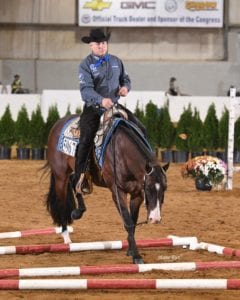 Charlie Cole – If you knock a pole or obstacle down, fix it. Don’t stop and stand in an obstacle. Look up and don’t be in your own little world. Don’t hog an obstacle. Most important, be courteous.
Charlie Cole – If you knock a pole or obstacle down, fix it. Don’t stop and stand in an obstacle. Look up and don’t be in your own little world. Don’t hog an obstacle. Most important, be courteous.
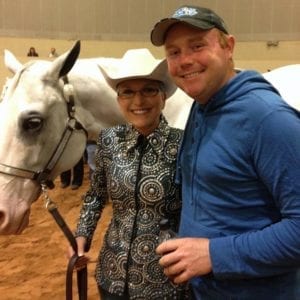 Blake Carney – There are quite a few things that frustrate me.
Blake Carney – There are quite a few things that frustrate me.
1) Trainers standing in the way of obstacles while they are coaching, and I admit fully that sometimes that’s me.
2) If you need more than one or two times through an obstacle that is giving you trouble, give some others an opportunity to come on through and then retake your turn.
3) I think it’s wise of management to be aware of the patterns they created and plan practice times accordingly. Sometimes pattern paths interfere, and that makes it so difficult when everyone is trying to practice at once and might be coming from different directions. I’m not going to lie; sometimes I miss the days where we didn’t have trail practice at all.
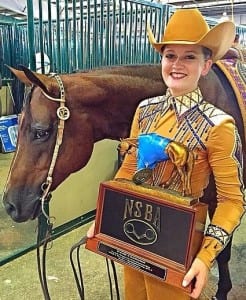 Carli Pitts – The trail pen can be an intimidating place at times. Everyone out there is practicing something different. I know that I’ll watch for trainers that are helping their non-pro with a particular obstacle and either wait until they’re done working it or move to a different one. It can be hard with five horses on one lope obstacle, and I understand that. Also, there’s an unwritten rule of the line at the gate. It’s a slow obstacle, and it doesn’t bother me if someone has to practice it five times in a row. But, I know how trail practice is and if someone accidentally runs into me, it doesn’t bother me because we’ve all been there.
Carli Pitts – The trail pen can be an intimidating place at times. Everyone out there is practicing something different. I know that I’ll watch for trainers that are helping their non-pro with a particular obstacle and either wait until they’re done working it or move to a different one. It can be hard with five horses on one lope obstacle, and I understand that. Also, there’s an unwritten rule of the line at the gate. It’s a slow obstacle, and it doesn’t bother me if someone has to practice it five times in a row. But, I know how trail practice is and if someone accidentally runs into me, it doesn’t bother me because we’ve all been there.
 Isabel Scobie – People who hog an obstacle when it’s obvious others are waiting. People who don’t do the pattern when it’s crowded, and you’re expecting them to go in the direction of the pattern. They don’t, and it can be dangerous. People are standing around in the pattern, this includes trainers. People who use the pattern to train their horse, i.e., staying in the back up to teach the horse not to anticipate. That should have been done at home or find some poles somewhere and do that. Dogs running loose, very dangerous.
Isabel Scobie – People who hog an obstacle when it’s obvious others are waiting. People who don’t do the pattern when it’s crowded, and you’re expecting them to go in the direction of the pattern. They don’t, and it can be dangerous. People are standing around in the pattern, this includes trainers. People who use the pattern to train their horse, i.e., staying in the back up to teach the horse not to anticipate. That should have been done at home or find some poles somewhere and do that. Dogs running loose, very dangerous.
 Becky George – 1) Try to go with the flow of the pattern. I realize we all need to do the obstacles in different orders, and sometimes do the whole course backward for the benefit of our horses, but when it is super busy in the warm-up pen, this causes chaos. You can always wait until later when the course frees up if you need that.
Becky George – 1) Try to go with the flow of the pattern. I realize we all need to do the obstacles in different orders, and sometimes do the whole course backward for the benefit of our horses, but when it is super busy in the warm-up pen, this causes chaos. You can always wait until later when the course frees up if you need that.
2) We all do it but need to be more aware of hogging an obstacle. It’s frustrating when you’re waiting to practice the gate, and someone keeps going over and over again without even offering it to you for practice.
3) Be courteous to the non-pro riders practicing, especially the young kids. The trail warm-up is intimidating enough for them, let alone if they have more experienced exhibitors getting frustrated with them.
4) Standing in the path of an obstacle. Sometimes it is hard to find a place to stand to be out of the way while you are coaching or just waiting on the next obstacle but again, watch the flow of the pattern, and you can figure it out.
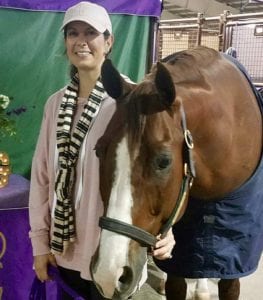 Kimberly Guenther – It’s taken years for me to overcome the fear of the trail warm up. If your horse is green, or you’re there without a coach, you can easily get bullied, and it’s happened to me many times. Something that could make the most significant difference in the chaos is if people could only say, “sorry!” There is no way to avoid occasionally being in someone’s way, and sometimes your focus is on an issue with your horse or the instructions from your coach, and you don’t see another rider until it’s too late. Cutting someone off, bumping into another person’s horse, yielding to the left when someone expected you to go right…these things will happen. But, what makes a huge difference in the experience is when someone acknowledges the blunder and apologizes. Even if you think it wasn’t your fault, a smile and a “so sorry!” goes a long way. Acknowledging to your fellow exhibitors that you know you don’t “own” the arena could make the culture of the trail warm-up pen a whole less intimidating.
Kimberly Guenther – It’s taken years for me to overcome the fear of the trail warm up. If your horse is green, or you’re there without a coach, you can easily get bullied, and it’s happened to me many times. Something that could make the most significant difference in the chaos is if people could only say, “sorry!” There is no way to avoid occasionally being in someone’s way, and sometimes your focus is on an issue with your horse or the instructions from your coach, and you don’t see another rider until it’s too late. Cutting someone off, bumping into another person’s horse, yielding to the left when someone expected you to go right…these things will happen. But, what makes a huge difference in the experience is when someone acknowledges the blunder and apologizes. Even if you think it wasn’t your fault, a smile and a “so sorry!” goes a long way. Acknowledging to your fellow exhibitors that you know you don’t “own” the arena could make the culture of the trail warm-up pen a whole less intimidating.
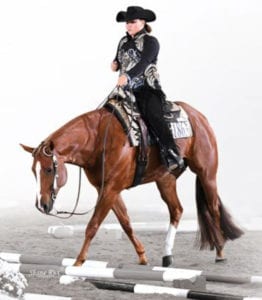 Ashley Dunbar-Clock – Things that drive me crazy when practicing and schooling trail is people who go around looking down and are not aware of their surroundings. When I go out, I try to be very courteous of everyone around me and no horses coming up from behind me or to my right and my left. Unfortunately, practicing trail is kind of like driving on the highway; you have to watch out for everyone around you and your surroundings or accidents can happen. Another thing to be courteous of is schooling on an obstacle that you messed up or moved it far. I usually try to find someone to help fix it for me, or I usually get off my horse to fix it myself. I’m not always perfect at it, but I usually try. Also, a trainer schooling several non-pros sometimes doesn’t realize that there is a line waiting for an obstacle and they try to cut in front. The biggest thing in the trail pen is to make sure you’re not cutting people off.
Ashley Dunbar-Clock – Things that drive me crazy when practicing and schooling trail is people who go around looking down and are not aware of their surroundings. When I go out, I try to be very courteous of everyone around me and no horses coming up from behind me or to my right and my left. Unfortunately, practicing trail is kind of like driving on the highway; you have to watch out for everyone around you and your surroundings or accidents can happen. Another thing to be courteous of is schooling on an obstacle that you messed up or moved it far. I usually try to find someone to help fix it for me, or I usually get off my horse to fix it myself. I’m not always perfect at it, but I usually try. Also, a trainer schooling several non-pros sometimes doesn’t realize that there is a line waiting for an obstacle and they try to cut in front. The biggest thing in the trail pen is to make sure you’re not cutting people off.
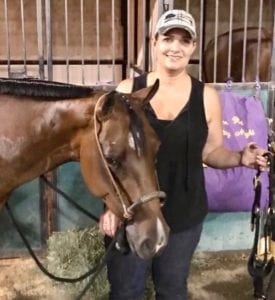 Kathryn deVries Mitchell – The thing that drives me the craziest is people who hog an obstacle when they are not showing or not going to show in the next few goes. When you are like one or two to go in and you need one more go over a particular obstacle and can’t because someone is sitting in it or not paying attention, it gets old. Also, just general awareness of others schooling over the same obstacle, we can all take turns and play nice.
Kathryn deVries Mitchell – The thing that drives me the craziest is people who hog an obstacle when they are not showing or not going to show in the next few goes. When you are like one or two to go in and you need one more go over a particular obstacle and can’t because someone is sitting in it or not paying attention, it gets old. Also, just general awareness of others schooling over the same obstacle, we can all take turns and play nice.
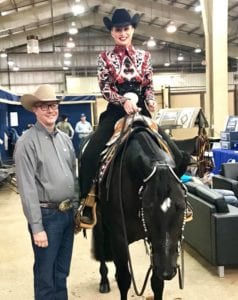 Johnna Letchworth Clark – Know where you are supposed to be going, but at the same time, keep in mind everyone is trying to go in the same general direction. Also, keep in mind, the majority of people practicing are not going to run through the pattern from start to finish. Be willing to stop and change things up a bit. Everyone out there has the same goal, so be polite. One last thing would be if you are headed out to walk the pattern during trail warm-up.. stay out of the way. No one wants to see you get hit.
Johnna Letchworth Clark – Know where you are supposed to be going, but at the same time, keep in mind everyone is trying to go in the same general direction. Also, keep in mind, the majority of people practicing are not going to run through the pattern from start to finish. Be willing to stop and change things up a bit. Everyone out there has the same goal, so be polite. One last thing would be if you are headed out to walk the pattern during trail warm-up.. stay out of the way. No one wants to see you get hit.
 Tonya Brown – If you are not showing and some people are trying to show, give them the obstacle and stay out of the way. Also, don’t stand in the backthrough for 20 minutes, and if you destroy an obstacle, then have someone reset it.
Tonya Brown – If you are not showing and some people are trying to show, give them the obstacle and stay out of the way. Also, don’t stand in the backthrough for 20 minutes, and if you destroy an obstacle, then have someone reset it.
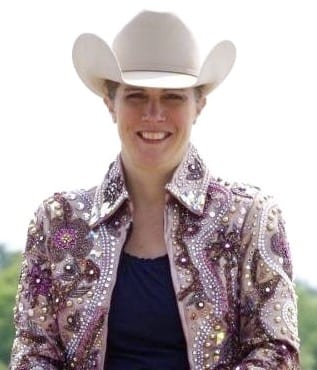 Heather Lange – The trail warm-up is not for the faint of heart. When it’s right, it’s a well-choreographed dance – two or three horses can work the same obstacle at once. But when it’s wrong, watch out.
Heather Lange – The trail warm-up is not for the faint of heart. When it’s right, it’s a well-choreographed dance – two or three horses can work the same obstacle at once. But when it’s wrong, watch out.
I think we all sometimes forget that we don’t have to start our warm up the minute the course is opened. Waiting even 30 minutes can make a massive difference in attitude (mine) and success (again, mine).
Know what you need out of your warm up today and then execute that plan. Do I need to focus on one or two obstacles or do I need to ride each obstacle in order? If the junior/novice pattern runs the opposite direction of my pattern, when is the best time for me to be on course?
If you are going to school off pattern, let the rest of us know. I get that you need to roll back and lope the other lead or slam on the brakes, but a heads up helps us all.
And if you are the experienced rider in a crowded pen, please remember, you were once a novice too. A kind word or just telling a novice rider where you are heading can make their experience better also.
 Hilary Reinhard -The trail practice pen can be daunting. And at some shows, the practice pen can be very tight and crowded.
Hilary Reinhard -The trail practice pen can be daunting. And at some shows, the practice pen can be very tight and crowded.
My suggestions are:
1) Be aware of your surroundings…both while riding and parked waiting for your go. Look up while riding and don’t park in a pathway.
2) Realize that it is a hectic environment. If you or your horse get rattled, try to practice during quieter times. It won’t be as convenient, but it can make it a lot more productive.
3) If you are working on a slower obstacle, pay attention to people who may be waiting to practice.
4) If you knock a pole over or move it, fix it in a proper timeframe.
5) Be polite. It’s hectic and can be stressful, and you will cut someone off or be in someone’s way. Apologize and understand when it happens to you.
What are your trail warm up pet peeves? Let us know!




